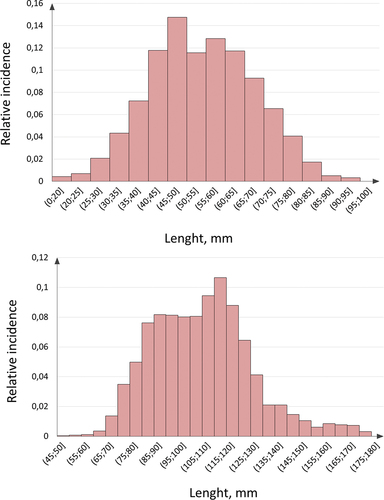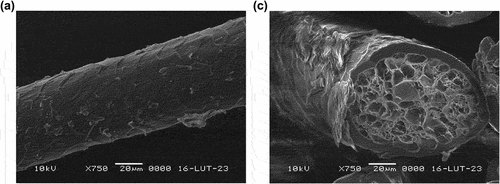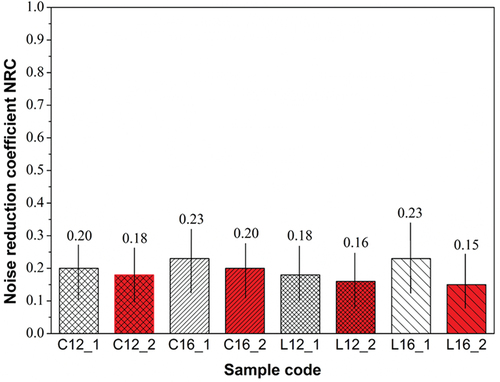ABSTRACT
Coarse wool from Polish mountain sheep, often treated as a useless by-product of sheep husbandry, was used to produce pile carpets with tufting technique. Raw wool was used in the small-scale spinning mill to spin prototype rug yarns, which were then used for the production of carpets. The carpets with cut and loop piles of two different heights and densities were manufactured. During examinations, the basic parameters of raw wool, yarns, and tufted fabrics were determined. Then, the soundproofing properties of carpets were analyzed. To characterize the acoustic properties of the carpets, the sound absorption coefficient and transmission loss were measured. The measurements were carried out in one-third octave bands in the frequency range of 80–5000 Hz using the impedance tube method. It was stated that the wool of Polish mountain sheep is coarse, highly differentiated both in thickness and length and contains a significant content of medullated fibers and kemp. Despite its poor characteristics, the wool can be used for the production of rag yarns suitable for the production of pile carpets with tufting technique. The carpets possess acceptable sound absorbing capacity comparable to other similar products obtained from other wool types, which is dependent on both pile types and their parameters. The carpets exhibit low transmission loss, which is influenced, to a lesser extent, by the change in the parameters of the pile layer.
摘要
波兰山羊的粗羊毛通常被当作牧羊业的无用副产品,用于生产簇绒地毯. 原毛在小型纺纱厂中被用来纺地毯原纱,然后用于生产地毯. 制造了具有两种不同高度和密度的切绒和毛圈绒的地毯. 在检测过程中,确定了毛料、纱线和簇绒织物的基本参数. 然后对地毯的隔音性能进行了分析. 为了表征地毯的声学特性,测量了地毯的吸声系数和传输损耗. 使用阻抗管法在80-5000 Hz频率范围内的三分之一倍频带中进行测量. 据称,波兰山地绵羊的羊毛质地粗糙,在厚度和长度上差异很大,并且含有大量的髓纤维和kemp。尽管其特性较差,但该羊毛可用于生产适合于用簇绒技术生产绒头地毯的碎布纱线. 与从其他羊毛类型获得的其他类似产品相比,地毯具有可接受的吸声能力,这取决于绒头类型及其参数. 地毯表现出低的传输损耗,这在较小程度上受到绒毛层参数变化的影响.
Introduction
Sheep wool is one of the sustainable natural raw materials which have been well known to the human race since ancient times (Rast-Eicher and Jørgensen Citation2013). For centuries, in addition to apparel textiles, wool was a basic fiber used to produce rugs and carpets. Carpet manufacturing was known and had great importance in many ancient civilizations. In many countries, wool carpets became a symbol of social status and played different utilitarian and symbolic roles (Ryder Citation2001; Serrano et al. Citation2021).
The most widespread pile carpets consist of a top layer and a backing. The top layer is composed of overhanging yarn segments arranged in a compact system formed from loops or upright tufts. The backing provides carpets with appropriate dimensions and dimensional stability and is made of woven or nonwoven fabric.
The first technique used for manufacturing pile carpets was hand knotting. Symmetrical or asymmetrical knots were wrapped and fastened around one or two adjacent warp strands stretched between two parallel beams of the loom. The ends of yarns in knots were cut off at the right height to form the pile surface. Using knots of different colored threads, a carpet pattern was created. A row of knots was tightly beaten up and anchored by either one or two shots of the weft. The weft compacted the row of knots and formed a properly tight structure of the backing.
The art of knotting was developed several thousand years ago on the plains of Central Asia. The oldest wool pile carpet, estimated to be over 2400 years old, was found in a Scythian barrow grave in the Pazyryk Valley in the Altai mountains in Siberia (Ingham et al. Citation2016). With time, the art had spread all over the world and had been adopted in different oriental countries.
Introducing mechanical looms in the eighteenth century considerably accelerated the carpet manufacturing process (Wood Citation2009). In woven carpets, the entire structures of pile and backing are formed simultaneously. Depending on the technique used, there are two main types of woven carpets: Axminster carpets and Wilton. Axminster carpets (except chenille carpets) are made by inserting the ends of the individual tufts in the loom between the warp threads. Then, the weft yarn is inserted, pile ends are up and fastened in place by the next weft. The warp and weft threads are tightened, locking the tufts in place. This group also includes the so-called chenille rugs made from specially prepared multicolor chenille weft threads. Wilton weave carpet is the one in which the pile threads run continuously along the warp system and are raised above the surface of the integral backing using wires or a face-to-face technique. In the face-to-face technique, bundles are formed from continuous pile warp threads that switch places between two parallel woven articles. The warp threads are then cut, giving two carpets with identical patterns.
The carpet weaving industry was initially developed in Europe, in Brussels (Belgium), Wilton, Axminster, and Kidderminster (England). In the nineteenth century, the introduction of powered looms and later the Jacquard patterning mechanism enabled the production of big and richly decorated carpets on a large scale.
The next development in carpet production took place in the twentieth century in the USA when the tufting technique was introduced. The technique involves stitching the yarn into the backing fabric to create a loop, cut, or mixed piles. Loop piles are formed when the yarn inserted is caught by loopers and pulled through the backing to a set length. Cut piles are formed by cutting the piles at their maximum length, with blades operating in tandem with the loopers (Moody and Needles Citation2004). The primary backing holds the tufted yarns during the manufacturing process and gives the structure its initial three-dimensional stability. The secondary backing is added to the pile structure to enhance the carpet’s final dimensional stability, strength, and stretch resistance and protect the bunches from being pulled out.
The hand tufting technique was invented at the end of the nineteenth century in Dalton (Georgia, USA) where it was first applied for handicraft production of bedspreads, mats, and bathrobes. In the 1930s, a modified single-needle commercial sewing machine was adopted for tufting. The machine enabled tufting of thick yarn into muslin without tearing the fabric and was coupled with a knife to cut the loops. In the next few years, tufting machines with four, then eight, twenty-four, or more needles enabling the formation of parallel rows were constructed. Machines were introduced to the industrial practice, which soon resulted in the rapid growth of the mechanized tufting industry. After the second world war, in the 1950s, tufting machines were getting more and more common and were equipped with several hundred needles to stitch hundreds of pile yarn rows. In the next years, tufting dominated carpet manufacturing. It is estimated that nowadays, tufting is a common technique widely used for the production of 90% of the carpets available in the market.
The introduction of the tufting technique on a large scale coincided with the development of new synthetic fibers. Application of these fibers significantly accelerated the growth of carpet production. The new yarns, continuous filament nylon yarns in particular, provided good quality and high durability of carpets at a relatively low price.
Despite the rapid development of the production of synthetic carpets, wool products have retained their high status as top-quality luxury goods. In contrast to synthetic fibers, wool is a sustainable, renewable, biodegradable, and easily recyclable material (Wiedemann et al. Citation2020). Wool fibers are obtained during the annual or bi-annual shearing of sheep which are bred worldwide in harmony with local climate, altitude, and vegetation. Traditional farming practices developed over centuries are environmentally friendly, socially and culturally compatible, desirable for rural development and beneficial to landscape conservation and maintenance of botanical biodiversity (Dýrmundsson Citation2006; Solazzo et al. Citation2013). As a protein-based fiber, wool is relatively easily decomposed by natural enzymes into low molecular compounds and biodegrades readily in both soil and water (Broda et al. Citation2016). Furthermore, it is readily recyclable (McNeil, Sunderland, and Zaitseva Citation2007; Navone et al. Citation2020). Wool textiles have been recycled for longer than any other fiber type and are one of the textiles with the highest recycling level. The market share of recycled wool reaches 5% of all textile fibers, with only a 1.2% share in the total fiber consumption (Russell and Ireland Citation2016). Wool is naturally flame resistant. Due to its high ignition temperature, it is difficult to ignite When burning, it reveals low propensity for flame spread, produces little smoke, does not melt or drip, emits low amounts of toxic substances, and is easily extinguishable (Cardamone Citation2013). Under normal atmospheric conditions, wool reveals a low static charge accumulation (it possesses a high odor absorption capacity and can absorb up to 30% of the weight of water vapor) (Hegyi et al. Citation2021; Mansour et al. Citation2016; Ormondroyd et al. Citation2017). Moreover, wool shows high resistance to soiling and is easy to clean. The carpets tend to be washed less frequently at lower temperatures, so their maintenance has less impact on the environment. Additionally, wool is highly flexible, which enables the fibers to bend thousands of times without suffering permanent damage or deformation. Wool carpets have relatively long lifespans and are usually used longer than carpets manufactured from other natural and synthetic fibers.
Wool carpets used as floor coverings and interior decorations offer additional considerable advantages in terms of thermal insulation and heat balance in buildings (Bakker Citation2018; Diswat, Hes, and Bal Citation2016; Mcneil, Bulletin, and Zealand Citation2016). Moreover, such carpets are highly effective in controlling indoor noise and reducing the reverberation of sound signals. Carpets are some of the most versatile sound-absorbing materials which absorb airborne sounds and reduce surface noise generation. They effectively eliminate floor impact sounds of footfalls, furniture movement, and objects dropped onto the floor. Additionally, carpets reduce the impact of sound transmission between stories in multi-stored buildings.
The acoustic performance and mechanism of sound absorption in wool carpets have been rarely discussed in the literature (Harris Citation1955). The papers presenting the acoustic performance of wool products focus on fibrous sound-absorbing materials such as mats, panels, felts, nonwovens, or other textiles manufactured using well-known techniques (Ballagh Citation1996; Broda and Baczek Citation2020; Patnaik et al. Citation2015; Segura Alcaraz et al. Citation2021; Soltani and Zerrebini Citation2012; Witczak et al. Citation2021). Most of these products are created from randomly distributed loose fibers or have a structure achievable through textile processing. The materials are highly porous and contain an interconnected system of numerous open pores. The pores reduce the reflection of sound waves and allow them to soak in the fibrous assembly. When propagating through the pore network, a sound wave generates vibrations of the air molecules accumulated within the pores. Due to the friction against the irregular pore walls, the oscillating air molecules lose their energy. As a result, the energy of the sound wave is transformed into thermal and viscous heat which is finally dissipated.
The structure of common wool sound-absorbing materials differs considerably from the structure of pile carpets which are composite and consist of at least four components: surface pile layer, primary backing, a layer of adhesive compound, and a secondary backing fabric. In certain applications, another additional underlying in the form of nonwoven, felt, or foam is used. These particular components have different resonant frequencies at which they best absorb the sound waves, providing carpets with absorption ability over a wide range of sound frequencies. The surface piles reduce the reflection of sound waves back into the room and allow penetration of the sound into the pile and carpet backing. In the pile layer, sound waves cause vibrations of air molecules both in the individual fibers and pile tufts. The energy dissipated by friction between vibrating air molecules and piles increases with the increasing interphase contact surface. The increment of the contact surface caused by the increase in the pile density or height results in higher absorption capacity. This dependence was clearly shown during experimental studies performed for acrylic and wool carpets (Shoshani and Wilding Citation1991). It was also revealed that the higher sound absorption capacity possesses cut pile carpets and the loss of energy by air molecules caused by friction occurs more intensively at higher sound wave frequencies. Later, studies on acrylic and polypropylene carpets confirmed that carpets with longer piles and dense loops possess the best sound absorption rates (Küçük and Korkmaz Citation2017, Citation2019). Investigations have also shown that additional underlying contributes significantly to carpet absorption capacity (Ardekani et al. Citation2021; Elkhateeb et al. Citation2016). For carpets with open back, the combined performance of carpet and underlying is approximately equal to the sum of absorption coefficients of the separate parts (Ford and Bakker Citation1984). The increase in the noise absorption capacity of the backed carpets depends primarily on the thickness of the backing (Shoshani Citation1992).
Carpets are made from a coarser type of wool, the so-called carpet wool (Ansari-Renani Citation2012; Dashab et al. Citation2006). To achieve superior carpet appearance and performance, as well as to meet the spinning system, yarn properties, and carpet manufacturing technique requirements an appropriate wool has to be selected. Several key properties are taken into account, such as mean fiber diameter, fiber length, medullation, and base color.
In our previous studies, the acoustic performance of felt and fabrics manufactured from Polish mountain sheep wool was analyzed (Kobiela-Mendrek et al. Citation2022). The investigations showed that the wool of mountain sheep, which is often disregarded and treated as a waste product of sheep husbandry, is a valuable raw material that can be used to produce that can be used to produce materials with good sound-absorbing properties. This paper presents the results of further studies on the utilization of coarse wool obtained from mountain sheep to produce rag yarns suitable for the production of pile carpets with the tufting technique. During the investigations, the raw wool and yarns were characterized in detail, and the possibility of using yarns in the tufting technique was explored. Then, the sound absorption capacity and transmission loss of the obtained materials in relation to the type of piles, pile height, and density were analyzed.
Materials and methods
Materials
Wool obtained from Polish mountain sheep was applied as a raw material. The wool was collected during the summer shearing of a flock raised in southern Poland, in the Silesian Beskid Mountains, the western part of the Carpathian Mountains (Salachna et al. Citation2022). Pile yarn was manufactured using naturally colored fleeces of dark gray and dark brown, separated during sheep shearing.
In order to remove grease and other natural impurities, the wool was scoured in industrial conditions using the six-bath technological line.
For yarn manufacturing, the classic ring spinning technique was applied. In the first step, the card web was formed into slivers which were then drawn twice on the pin drafter. Drawn slivers were spun into a yarn and then twisted into folded yarn. Finally, the twist of the finished yarn was stabilized in a yarn steaming chamber. Spinning was carried out in a small-scale spinning mill with the use of carding and spinning machines supplied by Belfast Mini Mills (Prince Edward Island, Canada) and Ramella (Biella, Italy). The yarn was manufactured using a dual-function machine, ring-spinning frame, and plyer, equipped with a double drafting unit.
Tufting samples were produced by means of manual pneumatic tufting guns. Pile yarns were punched with the tubular needle of the gun into a pre-stretched primary backing fabric mounted on a horizontal frame. The primary backing fabric was a polyester plain weave cloth with the square set of 70 dm−1 and yarns’ linear density of 180 tex. To prevent the piles from being pulled out, a secondary backing was bonded with latex. The secondary backing was a leno fabric of polypropylene warp with the linear density of 33 tex and set equal 32 × 2 dm−1 and an acryl weft with the linear density of 125 tex and set equal to 40 dm−1.
Samples of tufted carpets with both cut and loop piles were produced. Two different pile heights and two different pile densities were obtained. For each variant, the samples with dimensions 300 × 300 mm were produced.
Methods
Raw wool
To characterize raw wool the basic parameters: thickness and length of scoured fibers were measured and then their morphology was examined. The fiber thickness measurements were carried out with the use of an optical microscope coupled with the image Aphelion Dev software. The fiber length was determined in accordance with PN-ISO 6989:2000 standard. The surface and cross-section morphology of the fibers were examined using the scanning electron microscope JEOL JSM 5500 LV. The microscopic observations were carried out in backscattered electron mode for fibers sputtered with gold in a JEOL JFC 1200 ionic sputter.
Wool yarn
The yarn’s basic parameters: average linear density, twist, and tenacity were determined. The measurements of linear density and twist were carried out according to the EN ISO 2060:1994 and PN-ISO 2061:2015 standards for yarns conditioned in a standard atmosphere. The twist of single and folded yarns was determined by untwisting the yarn to a parallel position using a twist tester. The yarn breaking force and elongation at break were determined using Instron 5544 – a universal tensile testing machine, according to the standard EN ISO 2062. The measurements were made at a gauge length of 250 mm and a rate of specimen extension of 250 mm min−1.
Tufted fabrics
The basic parameters of the tufted carpets: surface density and thickness were measured in accordance with Polish standards: PN-EN ISO 9863–1:2007 and PN-EN ISO 9864:2007. For carpet thickness measurements, the Tilmet 73 thickness gauge (Lodz, Poland) was used. Each parameter was determined as the mean of 10 measurements.
Acoustic properties
Acoustic properties of the tufted fabrics were characterized in terms of normal incidence sound absorption coefficient (α) (SAC) and normal incidence sound transmission loss (STL). These two acoustic parameters were measured with an impedance tube Sinus Messtechnik GmbH – AFD 1000, using a two- and a four-microphone method, respectively.
The measurements to determine the sound absorption coefficient and sound transmission loss were carried out for circular specimens with the diameters of 100 mm and 30 mm, respectively, in one-third octave bands in the frequency range of 80–5000 Hz. The large tube (sample diameter 100 mm) was used for measurements in the range of 80–1600 Hz, while the small tube (sample diameter 30 mm) for measurements in the range of 1600–5000 Hz. Two samples of each material were tested, and the mean values of the sound absorption coefficients and transmission loss were calculated. Based on the sound absorption measurement results, the noise reduction coefficient NRC was calculated. The NRC was calculated as the mean value of the sound absorption coefficients at 250, 500, 1000, and 2000 Hz.
Results
Raw wool
The preliminary measurements of the fiber thickness and length were carried out for a representative sample taken from a mixture of fibers sheared from tens of ewes randomly chosen from the flock. As a result of these measurements, histograms of two maxima were obtained for both fiber diameter and length (). On the histogram of the fiber thickness, the maxima occurred at 38 μm and 68 μm. The maxima were separated and located distant from each other. Similarly, in the fiber length histogram, two maxima located at 58 mm and 106 mm were visible. The histograms with two well-distinguished maxima indicate the occurrence of two fractions of fibers differing from each other in terms of both thickness and length.
Figure 1. Histograms for average sample of wool sheared from tens of ewes; a/fiber thickness; b/fiber length.
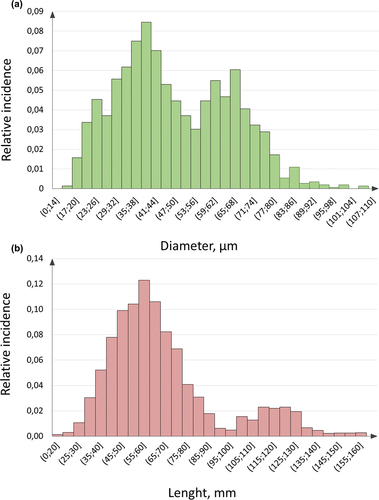
Assuming the normal distribution of fiber thickness and length, in the region between the two maxima on the histograms the bars corresponding to two fiber fractions overlap. In this case, the calculation of the mean value of fiber diameter or length for the whole set of fibers makes no sense. To avoid fatal errors, the measurements of fiber thickness and length in further studies were performed after fractions in both fibers had been manually separated. One visible fraction of more delicate, shorter and thinner wool and the second fraction of longer and thicker hairs were obtained (). The content of hair fractions in the fleece ranges between 50% and 66% by mass and varies slightly between particular animals.
Figure 2. Mountain sheep wool a/fleece; b/two fractions of fibers (wool and guarded hair) separated from the fleece.
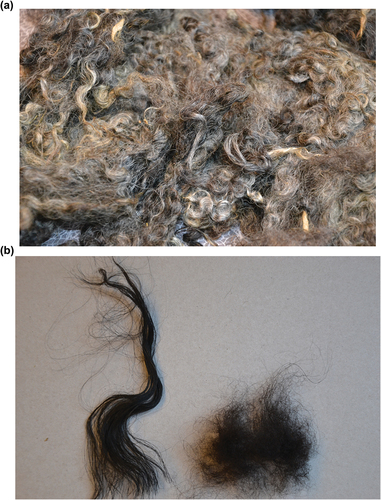
As a result of fiber thickness measurements performed after separating the fibers, histograms for wool and guarded hairs were generated (). For both fiber fractions measured for ewes of different ages, one maximum and a normal distribution of fiber thickness were observed. For the wool, the mean diameter was 36,60 ± 0,65 µm. The thickness of the guarded hairs was greater and equaled 64,69 ± 0,91 µm.
Similarly, histograms of the fiber length measured separately for wool and guarded hairs revealed one maximum and a normal distribution (). For animals of different ages, the mean length of wool amounted to 54 ± 6 mm. For guarded hairs, the fibers were significantly longer and their mean length was 105 ± 6 mm.
During the microscopic studies, the surface and cross-section morphology of wool and guarded hairs taken from ewes of different ages were analyzed. On the surface of the majority of fibers taken from lambs, one can observe scales forming patterns of different waved mosaics (). The fine scales with smooth margins overlap one another. The scales possess low thickness and only slightly stick out above the surface of the fibers. Due to this scale arrangement, the fibers are delicate and smoother. For the thinnest fibers with a diameter below 20 µm, the coronal scale pattern is observed (). In this case, the scales encircle the entire shaft of the fiber. For the wool of eight-year-old ewes, similarly, as for the younger animals, the waved mosaic pattern is observed. The scales with various shapes and sizes between 10-and 20 µm form a more or less regular mosaic (). Compared to the wool of young animals, the scales are much thicker, which makes their surface rougher. The cross-section of the wool fibers is round. In accordance with the fiber thickness measurements, the diameter of particular fibers fluctuates around 30 µm. The vast majority of the fibers have no medulla (.
Figure 5. Surface morphology and cross-section of wool; a/and b/one-year-old sheep; c/and d/the thinnest fibers of one-year-old sheep; e/and f/eight-years-old sheep.
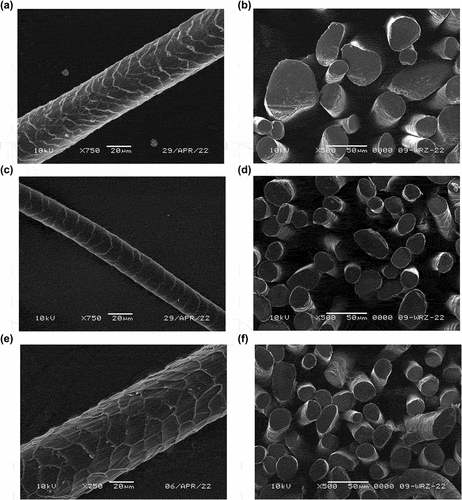
The scales of the fibers which form the guarded hairs are arranged into mosaic patterns regardless of the age of the sheep. For all fibers, the scales have smooth edges. The fibers of young animals have thinner scales and smoother surface (). The scales in the wool of the older animals are much thicker and their edges protrude from the surface of the fibers (). As a result, the surface is uneven and significantly rougher. For all hairs, irrespective of sheep age, the cross-section is round. Regardless of the age of the sheep, the hairs are much thicker than the wool and their diameter exceeds 50 µm (). For almost all hairs in the cross-section, the medulla is visible (). The medulla of a diameter between few to a dozen µm is located in the central part of the fibers and occupies approximately 5–10% of the cross-section area.
Figure 6. Surface morphology and cross-section of guarded hairs; a/and b/one-year-old sheep; c/and d/eight-years-old sheep.
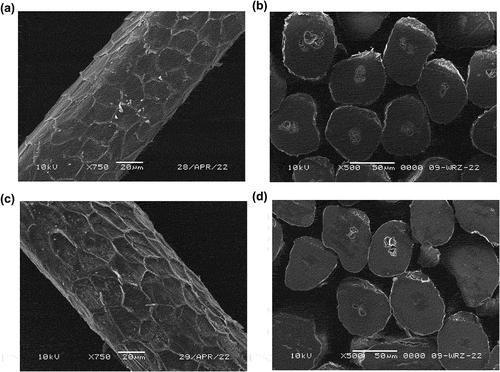
In addition to typical medullated fibers, which dominate in guarded hairs, in the fleece numerous thicker fibers with a great medulla occur. These fibers, called kemp, occur both for young and old ewes and their content varies for particular animals. On the surface of the kemp, scales arranged into mosaic patterns similar to the patterns observable for other types of fibers are visible (). In the cross section, the kemp takes up more than 60% of the fiber diameter ().
Yarn characteristics
As a result of spinning, the ring-spun three-plied yarn was obtained. At a linear density of a single yarn equal to 400 tex, the linear density of the three-plied yarn was 1240 tex. The fibers of a single yarn were twisted in the Z-direction with a twist of 170 ± 40 m−1. The three-plied yarn was twisted in the opposite S-direction with the twist of 60 ± 7 m−1. The three-plied yarn 400 tex Z 170 × 3S 60; R 1240 tex was strong and showed high tenacity of 9.80 ± 0.27 N. At high strength, the yarn has a relatively low deformability. The elongation at break is 14.4 ± 0.8%.
Properties of tufted fabrics
The parameters of the tufted fabrics with cut and loop piles are summarized in .
Table 1. Parameters of tufted carpets produced from mountain sheep wool.
Table 2. Basic parameters of tufted fabrics with cut and loop piles.
The measured thickness of fabrics includes the thickness of the pile layer and backing. The thickness is greater for samples with the greater pile heights and equals 14 mm and 18 mm for piles 12 mm and 16 mm high, respectively. The surface density ranges from 2900 gm−2 to 4200 gm−2. Obviously, for both cut and loop piles, the surface density is greater at greater pile height and density.
Acoustic properties of tufted samples
Sound absorption coefficient
The sound absorption coefficient (SAC) changes with the sound wave frequency. For all investigated samples, the SAC is very low at low frequencies below 250 Hz and has a constant value within the whole low-frequency range. At medium frequencies between 250 and 1000 Hz, the SAC value increases slightly. Then, at higher frequencies – above 1000 Hz by increasing frequency, the SAC grows considerably, so that at the end of the measured range – at 5000 Hz – it is very high, close to the highest possible value.
For samples with cut piles with the lower height of 12 mm, for low and high pile density, at low frequencies, the SAC achieves a low value of 0.03. In the medium frequency range, the SAC for both densities grows slightly to 0.17. At higher frequencies, the SAC value increases significantly, up to 0.95 at 5000 Hz. For all frequencies in the high-frequency range, the SAC measured for samples with higher pile density is approximately 0.05 higher than the SAC of samples of lower density ().
Figure 8. Sound absorption coefficient for tufted samples with cut piles; a/pile height 12 mm; b/piles height 16 mm.
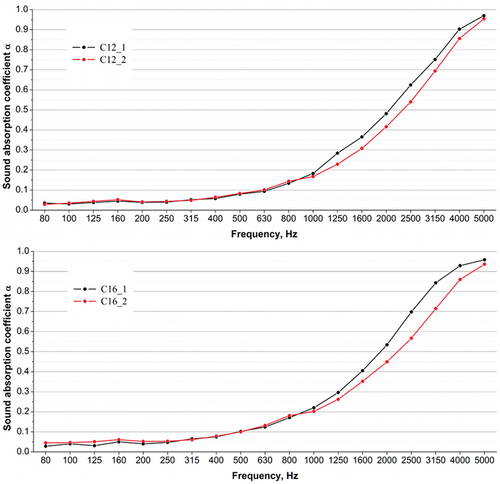
For samples with higher cut piles (16 mm), for higher pile density at low frequencies, the SAC equals 0.03, which is slightly lower than 0.05 measured for samples with lower pile density. At medium frequencies, the SAC slightly grows from 0.05 to almost 0.2. In this range, the SAC values are practically the same for both densities. In the high-frequency range, the SAC increases from 0.2 to approximately 0.96. In this range for higher pile density, the SAC values are significantly higher. The differences observed between the samples with different pile densities vary with the sound frequency. The largest difference, close to 0.15, is observed for frequencies 2500 Hz and 3150 Hz ().
For samples containing loop piles, at pile height of 12 mm in the whole range of low frequencies, the SAC value is very low and does not change with the growing sound frequency. Under medium frequencies, the SAC value slightly increases from 0.03 to 0.16. At both low and medium frequencies, there is no difference between samples of lower and higher pile density. In the high frequency range, the SAC grows significantly with increasing frequency. In this whole range for higher pile density, the SAC value is 0.05 to 0.13 higher. The highest difference in the SAC values between the samples of lower and higher pile density is observed at the highest frequency of 5000 Hz. The maximum value of the SAC achieved for loop piles at both lower and higher pile densities is much lower than the SAC obtained for samples with cut piles ().
Figure 9. Sound absorption coefficient for tufted samples with loop piles; a/pile height 12 mm; b/pile height 16 mm.
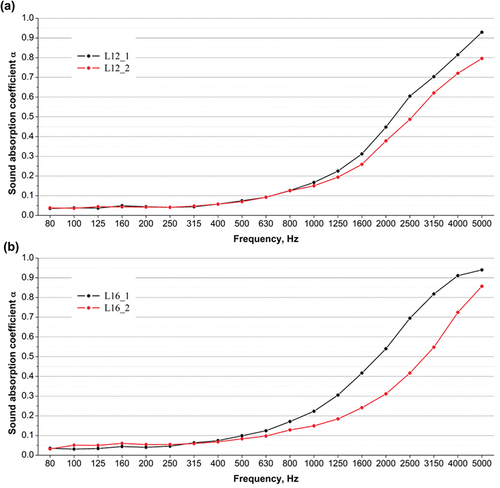
For samples with higher piles (16 mm), like for samples containing cut piles, the SAC in the low-frequency range is a little bit higher for samples with lower pile density. Under medium frequencies, up to 400 Hz for both samples with higher and lower pile densities, the SAC is the same. Above 400 Hz, it increases slightly and the increment of the SAC value for samples of higher density is larger. The differences between the samples with higher and lower densities become more pronounced with increasing frequencies and become even larger in the high-frequency range ().
The noise reduction coefficient (NRC) calculated for all the samples varies between 0.15 and 0.23 (). The lowest value of NRC is observed for samples containing loop piles at lower pile density, while the highest for samples with loop piles and higher pile height. For samples with both cut and loop piles, NRC is larger at higher pile density and greater pile height. For samples with cut piles, the difference in pile density is inconsiderable and equals only 0.02. For samples with loop piles, the difference is more distinguishable, even 0.08 for greater loop height.
Sound transmission loss
The sound transmission loss (STL) varies with the frequency of the incident sound wave. For all samples, independent of the type of piles and pile layer parameters, the observed trend of changes is similar. At very low frequencies, STL slightly decreases with increasing frequency and then achieves the lowest value in the frequency range between 125 and 1000 Hz. At higher frequencies above 1000 Hz, STL grows with the growth frequency and achieves the maximum value at the end of the measuring range.
The value of STL and its changes depend on the parameters characterizing the pile layer. In samples containing 12-mm-high cut piles, with lower pile density at low and medium frequencies, the STL fluctuates around 5 dB. Above 1000 Hz with the increase in the frequency, STL increases gradually till 10 dB. For higher pile density, STL at all frequencies is 2.5 times bigger and at the highest frequency of 5000 Hz it achieves the high value of 28 dB (). For higher piles (16 mm), with lower pile density and at lower frequencies, STL achieves the value of less than 5 dB. In the entire range of the medium frequencies, STL remains at the low level and then at high frequencies increases only minimally to 7 dB. For samples with higher pile density, STL in the low and medium frequency range is only 1 or 2 dB higher. Above 1000 Hz, the values of STL are growing and reach 15 dB, a value two times greater in comparison to the sample with lower pile density ().
Figure 11. Sound transmission loss for tufted fabrics samples with cut piles; a/pile height 12 mm; b/pile height16 mm.
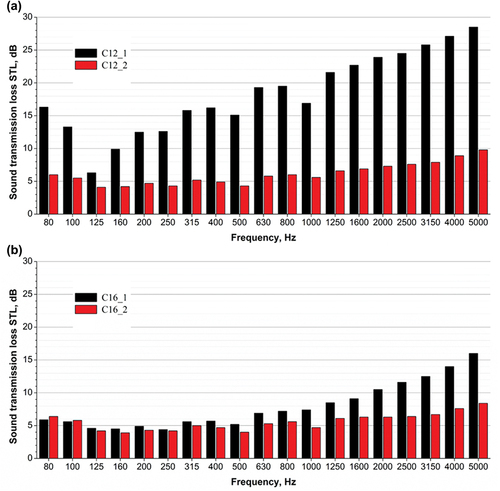
For samples containing loop piles, by the pile height of 12 mm, STL decreases from 9 dB to 5 dB at the beginning of the low-frequency range. At medium frequencies, the STL fluctuates around 6 dB and at higher frequencies, it increases up to 15 dB. For higher pile density and lower frequencies, STL is the same as for the samples with lower pile density. At medium and high frequencies and with higher pile density, the STL is approximately 5 dB greater (). For the samples with larger pile height, for lower pile density and at low and medium frequencies, STL varies between 2 and 3 dB, to increase to 7 dB at higher frequencies. With higher piles density, the values of STL are 4–5 dB greater ().
Discussion
The wool used in investigations was obtained from sheep raised in mid-height mountains in environmentally friendly conditions. The sheep are raised in accordance with the site-adapted transhumance pastoral system based on the seasonal migration of flocks between summer highland and winter lowland pastures. The system was developed in harmony with the local climate and vegetation and provides conditions for the sustainable production of wool and other sheep products (Salachna et al. Citation2022).
The wool obtained from the mountain sheep contains two fractions, which differ considerably in thickness, length, and content of the medullated fibers. The first fraction consists of thicker and longer guarded hairs with a significant content of medullated fibers and kemp. The second fraction is formed from thinner, shorter and more delicate wool without medullated fibers. The presence of two fractions is characteristic for primitive sheep breeds usually raised in harsh climatic conditions (Ryder Citation1981). These sheep possess a mixed-type fleece, in which the guarded hairs form the outer coat that protects animals against rain, abrasion, and other external factors, while the thinner wool forms the inner coat which ensures good thermal protection.
The diameter of wool fibers, even those forming the inner coat and taken from young, only one-year-old ewes, is considerably greater than the thickness of merino wool, commonly used for the production of luxurious apparel textiles (Adams and Cronjé Citation2003; McGregor and Butler Citation2016). The high thickness of fibers forming both the inner and the outer coat, is similar to the thickness of wool of various local breeds (Akraim et al. Citation2008; Dashab et al. Citation2006; Ghermezgoli, Moghaddam, and Moezzi Citation2020; Kicinska- Jakubowska et al. Citation2021; Kumar et al. Citation2021; Mehta et al. Citation2004). The thickness of the wool qualifies it as a class of coarse wool designed for the production of carpets, rugs, or blankets (Ansari-Renani Citation2012). The wool taken from each sheep is a blend of fibers of two fractions. They can only be separated manually, it is impossible in industrial conditions. In common practice, wool sheared from many animals from the flock is collected together. Due to various characteristics of fibers taken from individual animals, the resulting blend is even more diverse.
Great thickness, big differences in both thickness and length, and a significant content of medullated hairy type fibers and kemp make the processing of the mountain wool difficult. Nevertheless, the characteristic of the material does not disqualify it and does not make it useless and worthless. After removing heavily contaminated portions and waste fibers sheared from sheep legs, tails, and heads, the wool can be successfully processed in a small-scale technological line and used for spinning rug yarns. Unlike in the case of yarns intended for the production of high-quality apparel textiles, higher variability in fiber thickness and length is permissible here. By choosing the appropriate operating parameters for carding and spinning machines, ring-spun rug yarns with satisfactory properties can be obtained. Three-plied yarns are sufficiently strong and pliable and can be used for manufacturing pile carpets using the tufting technique.
Tufted carpets produced from yarns made from the wool of mountain sheep possess good acoustic insulating properties. For all the investigated carpets, regardless of the parameters characterizing the pile layer, the sound absorbing capacity is low for low sound frequencies and high for medium and higher frequencies. Such dependence is typical for fibrous insulating materials and was repeatedly observed for materials made from wool and other natural and synthetic fibers (Del Rey et al. Citation2017; Yang, Yu, and Pan Citation2011).
For the carpets tested, the determined noise reduction coefficient NRC, representing the average of sound absorption coefficients at mid-range frequencies, oscillates around 0.20. This value is similar to the NRC of wool carpets measured by other authors, but lower than the NRC of commercial products usually made from other wool types with thick underlying [56]. The relatively low NRC value for the investigated samples results from the thin carpet backing, consisting only of primary and secondary backing made from synthetic fibers connected with a thin latex adhesive layer.
The absorbing capacity of the carpets is dependent on the type of piles, pile height, and density. Carpets with cut piles possess better sound absorption capacity, approximately 10% higher in comparison to carpets with loop piles. Loop pile carpets are formed from tightly and closely packed loops which create a compact surface. The loops partially cover certain pores between the adjacent piles and hinder the penetration of sound waves into the pile layer. As a result, the sound absorption capacity is slightly lower and the reflection of a sound wave back into the room is greater. Contrary to the loop piles, the surface of cut piles is fuzzy and more open. Due to the open structure, the sound wave penetrates easier into and between the piles and the reflection of the sound wave back into the room is lower.
Piles in both types of tested carpets were over 10 mm high, a value which is recommended for carpets with good acoustic properties. Regardless of the type of pile, the absorption capacity is approximately 15% higher for carpets with higher piles. For higher piles, the path length of the sound wave passing through the pile layer is longer. Moreover, higher piles are more prone to deformation, which in turn increases the tortuosity and additionally lengthens the path for the sound wave moving inside the pile layer. Due to higher tortuosity and longer path, viscosity losses which convert acoustic energy into heat are greater and sound absorption is more effective.
The pile densities were selected taking into account the thickness of the yarn to ensure a compact structure of the pile layer. For carpets with higher pile density, for both cut and loop piles, the sound absorption capacity is 10–15% greater. It is connected with a greater contact area between the piles and air molecules. For larger pile density, the contact area is larger and the energy loss of the sound waves caused by friction becomes greater.
The relations observed between the sound absorption and the parameters of the pile layer are consistent with the results obtained earlier by other authors both for wool carpets and carpets made from acrylic and polypropylene fibers (Küçük and Korkmaz Citation2017, Citation2019; Shoshani and Wilding Citation1991).
The transmission loss STL, a measure of the efficacy of a carpet to reduce the transmission of sound energy, does not exceed 25 dB for all the samples tested. This value is relatively low and lower compared to carpets with a thick and dense underlying. As in the case of sound absorption, the transmission loss varies with sound frequency and changes depending on the pile type and pile layer parameters. For all the investigated carpets, regardless of the construction and parameters in the range of high sound frequencies, the transmission loss is larger, showing the highest value at the highest frequency – at the end of the measuring range. Taking into account the type of piles, one can notice that for bigger pile height and both densities, the STL is greater for carpets with cut piles. The STL is also greater for lower cut piles and lower pile density. In the case of higher pile density, the STL is greater for carpets with loop piles. Considering the pile height for all the investigated variants, the STL is smaller for higher piles as the thickness of the pile layer is greater and the length of the path of the sound wave to the backing is longer. With a longer path, the losses of the sound energy are larger and the transition loss should be greater. The observed changes are surprising and their explanation requires further investigations. When analyzing the influence of the pile density, one can notice that for all the variants with higher pile density, the transmission loss is greater. The increase of the pile density is connected with the increase in the surface density of the carpet, which consequently leads to the increase in the resistance of the airflow through the carpet and the increase in the volume of fibers that can dissipate energy by flexural vibration. This finding is consistent with the results obtained by other authors (Yakir Z. Shoshani Citation1990;).
Conclusions
The wool obtained from mountain sheep can be used to produce strong ring-spun rug yarns which are suitable for producing carpets with the tufting technique. The production of yarn and then the tufted carpet allows reasonable utilization of wool from local resources treated nowadays as a troublesome by-product of sheep breeding. Application of local wool contributes to the reduction of the amount of waste in the pastoral economy and is consistent with the European zero waste strategy.
Tufted carpets have a thick pile layer which significantly contributes to the carpets’ sound absorption capacity. This capacity depends on both type of piles and their parameters. The highest absorption is observed at high sound frequencies for carpets with cut piles for greater height and density. The impact of the pile layer on the transmission loss is less visible. The change of the pile type and parameters results only in minor changes in the transmission efficiency. To reduce the energy of sounds transmitted through the carpet, an additional underlying is required.
Apart from their decorative function, carpets produced from mountain sheep wool with the tufting technique can serve as valuable sound absorbing material to lessen noise, reduce reverberation, and improve the acoustic comfort of the room.
Author Contributions
Conceptualization, J.B. and K.K.M.; methodology, K.K.M., M.B., and M.R.; formal analysis, J.B. and M.B.; investigation, K.K.M. and M.B. resources, I.E.; writing – original draft preparation, K.K.M., M.B., and J.B.; writing – review and editing, and J.B.; supervision, J.B. and M.R.; project administration, J.B.; funding acquisition, J.B. and M.R. All authors have read and agreed to the published version of the manuscript.
Ethical approval
The research is not affected in any way by ethical issues. The study does not involve human embryos, human cells or human participants, and no personal data are collected and processed.
Consent
Details and images are freely available on the internet and may be seen by the general public.
Highlights
Coarse wool obtained from Polish mountain sheep, treated as a waste of little use, can be used to produce good-quality rug yarns
The rug yarns spun from the coarse wool of mountain sheep are suitable for the production of pile carpets with tufting technique.
The sound-absorbing capacity of carpets depends on both pile types and their parameters.
The transmission loss of carpets is relatively low and influenced, to a lesser extent, by the change in the parameters of the pile layer.
Disclosure statement
No potential conflict of interest was reported by the author(s).
Additional information
Funding
References
- Adams, N. R., and P. B. Cronjé. 2003. A review of the biology linking fibre diameter with fleece weight, liveweight, and reproduction in merino sheep. Australian Journal of Agricultural Research 54 (1):1–21. doi:10.1071/AR02059.
- Akraim, F., I. S. Milad, A. A. Abdulkarim, and M. Ganem. 2008. Wool characteristics of Libyan barbary sheep in North-Eastern Libya: I. Fiber diameter and staple length. Livestock Research for Rural Development 20:8.
- Ansari-Renani, H. R. 2012. Fiber quality of Iranian carpet-wool sheep breeds. Media Peternakan 35 (3):179–84. doi:10.5398/medpet.2012.35.3.179.
- Ardekani, T., A. Alamdar-Yazdi, M. Vadood, and M. Garai. 2021. Measuring and modelling the effect of base zone on sound absorption of Persian rug. The Journal of the Textile Institute 113 (12):2778–86. doi:10.1080/00405000.2021.2015109.
- Bakker, P. G. H. 2018. The acoustic and thermal properties of carpeted floors. Advances in Carpet Manufacture. doi:10.1016/b978-0-08-101131-7.00009-5.
- Ballagh, K. O. 1996. Acoustical properties of wool. Applied Acoustics 48 (2):101–20. doi:10.1016/0003-682X(95)00042-8.
- Broda, J., and M. Baczek. 2020. Acoustic properties of multi-layer wool nonwoven structures. Journal of Natural Fibers 17 (11):1567–81. doi:10.1080/15440478.2019.1584078.
- Broda, J., S. Przybyło, K. Kobiela-Mendrek, D. Binia, M. Rom, J. Grzybowska-Pietras, and R. Laszczak. 2016. Biodegradation of sheep wool geotextiles. International Biodeterioration and Biodegradation 115:31–38. doi:10.1016/j.ibiod.2016.07.012.
- Cardamone, J. M. 2013. Flame resistant wool and wool blends. Handbook of Fire Resistant Textiles. doi:10.1533/9780857098931.2.245.
- Dashab, G., M. A. Edriss, A. A. Ghare Aghaji, H. Movasagh, and M. A. Nilforooshan. 2006. Wool fiber quality of naeini sheep. Pakistan Journal of Biological Sciences 9 (2):270–76. doi:10.3923/pjbs.2006.270.276.
- Del Rey, R., A. Uris, J. Alba, and P. Candelas. 2017. Characterization of sheep wool as a sustainable material for acoustic applications. Materials 10 (11):111277. https://doi.org/10.3390/ma10111277.
- Diswat, J., L. Hes, and K. Bal. 2016. Thermal resistance of cut pile hand tufted carpet and its prediction. Textile Research Journal 86 (16):1759–67. doi:10.1177/0040517515612356.
- Dýrmundsson, Ó. R. 2006. Sustainability of sheep and goat production in North European countries—from the arctic to the alps. Small Ruminant Research 62 (3):151–57. doi:10.1016/j.smallrumres.2005.08.010.
- Elkhateeb, A., A. Adas, M. Attia, and Y. Balila. 2016. Absorption Characteristics of Masjid Carpets. Applied Acoustics 105:143–55. doi:10.1016/j.apacoust.2015.12.005.
- Ford, R. D., and P. G. H. Bakker. 1984. 16—The acoustical properties of various carpet and underlay combinations. The Journal of the Textile Institute 75 (3):164–74. doi:10.1080/00405008408658478.
- Ghermezgoli, Z. M., M. K. Moghaddam, and M. Moezzi. 2020. Chemical, morphological and structural characteristics of crossbred wool fibers. The Journal of the Textile Institute 111 (5):709–17. doi:10.1080/00405000.2019.1660459.
- Harris, C. M. 1955. Acoustical properties of carpet. The Journal of the Acoustical Society of America 27 (5_Supplement):1015–1015. doi:10.1121/1.1908124.
- Hegyi, A., C. Bulacu, H. Szilagyi, A. V. Lăzărescu, V. Meiţă, P. Vizureanu, and M. Sandu. 2021. Improving indoor air quality by using sheep wool thermal insulation. Materials 14 (9):2443. doi:10.3390/ma14092443.
- Ingham, P., S. McNeil, W. Meade, and M. Sunderland. 2016. Wool and carpets - 6000 Years of innovation, quality and sustainability. Key Engineering Materials 671:490–96. doi:10.4028/www.scientific.net/KEM.671.490.
- Kicinska- Jakubowska, A., A. Morales Villavicencio, M. Zimniewska, P. Przybylska, and E. Kwiatkowska. 2021. Evaluation of wool quality parameters of polish sheep breeds. Journal of Natural Fibers 19 (13):5880–87. doi:10.1080/15440478.2021.1902895.
- Kobiela-Mendrek, K., M. Bączek, J. Broda, M. Rom, I. Espelien, and I. Klepp. 2022. Acoustic performance of sound absorbing materials produced from wool of local mountain sheep. Materials 15 (9):3139. doi:10.3390/ma15093139.
- Küçük, M., and Y. Korkmaz. 2017. Sound absorption properties of acrylic carpets. The Journal of the Textile Institute 108 (8):1519–25. doi:10.1080/00405000.2016.1254582.
- Küçük, M., and Y. Korkmaz. 2019. Acoustic and thermal properties of polypropylene carpets: Effect of pile length and loop density. Fibers and Polymers 20 (7):1519–25. doi:10.1007/s12221-019-1181-1.
- Kumar, A., S. S. Misra, A. Chopra, H. K. Narula, R. C. Sharma, and G. R. Gowane. 2021. Sheep breeding in North-Western arid and semi-arid regions of India: An overview. Indian Journal of Small Ruminants 27 (1):1–10. doi:10.5958/0973-9718.2021.00013.1.
- Mansour, E., S. Curling, A. Stephan, and G. Ormondroyd. 2016. Absorption of volatile organic compounds by different wool types. Green Materials 4 (1):1–7. doi:10.1680/jgrma.15.00031.
- McGregor, B. A., and K. L. Butler. 2016. Coarser wool is not a necessary consequence of sheep aging: allometric relationship between fibre diameter and fleece-free liveweight of Saxon merino sheep. Animal 10 (12):2051–60. doi:10.1017/S1751731116001038.
- Mcneil, S., T. Bulletin, and N. Zealand. 2016. The thermal properties of wool carpets. Christchurch, New Zealand: Technical Bulletin, AgResearch.
- McNeil, S. J., M. R. Sunderland, and L. I. Zaitseva. 2007. Closed-loop wool carpet recycling. Resources, Conservation and Recycling 51 (1):220–24. doi:10.1016/j.resconrec.2006.09.006.
- Mehta, S. C., S. K. Chopra, V. K. Singh, M. Ayub, and V. Mahrotra. 2004. Production and quality of wool in magra breed of sheep. Indian Journal of Animal Sciences 74 (7):792–94.
- Moody, V., and H. L. Needles. 2004. Tufted carpet: Textile fibers, dyes, finishes and processes. Norwich: Wiliam Andrew.
- Navone, L., K. Moffitt, K. A. Hansen, J. Blinco, A. Payne, and R. Speight. 2020. Closing the Textile Loop: Enzymatic Fibre Separation and Recycling of Wool/Polyester Fabric Blends. Waste Management 102:149–60. doi:10.1016/j.wasman.2019.10.026.
- Ormondroyd, G. A., S. F. Curling, E. Mansour, and C. A. S. Hill. 2017. The water vapour sorption characteristics and kinetics of different wool types. The Journal of the Textile Institute 108 (7):1198–210. doi:10.1080/00405000.2016.1224442.
- Patnaik, A., M. Mvubu, S. Muniyasamy, A. Botha, and R. D. Anandjiwala. 2015. Thermal and Sound Insulation Materials from Waste Wool and Recycled Polyester Fibers and Their Biodegradation Studies. Energy and Buildings 92:161–69. doi:10.1016/j.enbuild.2015.01.056.
- Rast-Eicher, A., and L. B. Jørgensen. 2013. Sheep wool in bronze age and iron age Europe. Journal of Archaeological Science 40 (2):1224–41. doi:10.1016/j.jas.2012.09.030.
- Russell, S., and A. Ireland. 2016. Review of wool recycling and reuse. RILEM Bookseries 12. doi:10.1007/978-94-017-7515-1_33.
- Ryder, M. 2001. Ancient technique’s diverse designs. Wool Record 160:3681.
- Ryder, M. L. 1981. A survey of European primitive breeds of sheep. Genetics Selection Evolution 13 (4):381–418. doi:10.1186/1297-9686-13-4-381.
- Salachna, A., K. Kobiela-Mendrek, M. Kohut, M. Rom, and J. Broda. 2022. The pastoralism in the Silesian beskids (South Poland): In the past and today. Sheep Farming - Herds Husbandry, Management System, Reproduction and Improvement of Animal Health. doi:10.5772/intechopen.99722.
- Segura Alcaraz, M. P., M. Bonet-Aracil, E. Julià Sanchís, J. G. Segura Alcaraz, and I. M. Seguí. 2021. Textiles in architectural acoustic conditioning: A review. The Journal of the Textile Institute 113 (1):166–72. doi:10.1080/00405000.2021.1976483.
- Serrano, A., S. Meijer, R. R. van Rijn, S. B. Coban, B. Reissland, E. Hermens, K. J. Batenburg, and M. van Bommel. 2021. A non-invasive imaging approach for improved assessments on the construction and the condition of historical knotted-pile carpets. Journal of Cultural Heritage 47:79–88. https://doi.org/10.1016/j.culher.2020.09.012.
- Shoshani, Y. Z. 1990. Effect of nonwoven backings on the noise absorption capacity of tufted carpets. Textile Research Journal 60 (8):452–56. doi:10.1177/004051759006000804.
- Shoshani, Y. Z. 1992. Effect of nonwoven backings on the noise absorption capacity of tufted carpets. Yalkut Israel Textile Journal (129):16–19.
- Shoshani, Y. Z., and M. A. Wilding. 1991. Effect of pile parameters on the noise absorption capacity of tufted carpets. Textile Research Journal 61 (12):736–42. doi:10.1177/004051759106101207.
- Solazzo, C., J. M. Dyer, S. Clerens, J. Plowman, E. E. Peacock, and M. J. Collins. 2013. Proteomic evaluation of the biodegradation of wool fabrics in experimental burials. International Biodeterioration and Biodegradation 80:48–59. doi:10.1016/j.ibiod.2012.11.013.
- Soltani, P., and M. Zerrebini. 2012. The analysis of acoustical characteristics and sound absorption coefficient of woven fabrics. Textile Research Journal 82 (9):875–82. doi:10.1177/0040517511402121.
- Wiedemann, S. G., L. Biggs, B. Nebel, K. Bauch, K. Laitala, I. G. Klepp, P. G. Swan, and K. Watson. 2020. Environmental impacts associated with the production, use, and end-of-life of a woollen garment. The International Journal of Life Cycle Assessment 25 (8):1486–99. doi:10.1007/s11367-020-01766-0.
- Witczak, E., I. Jasińska, M. Lao, I. Krawczyńska, and I. Kamińska. 2021. The influence of structural parameters of acoustic panels textile fronts on their sound absorption properties. Applied Acoustics 178:107964. doi:10.1016/j.apacoust.2021.107964.
- Wood, E. J. 2009. Developments in wool carpet manufacture. Advances in Carpet Manufacture. doi:10.1016/B978-0-08-101131-7.00006-X.u.
- Yang, S., W. Yu, and N. Pan. 2011. Investigation of the sound-absorbing behavior of fiber assemblies. Textile Research Journal 81 (7):673–82. doi:10.1177/0040517510385177.


